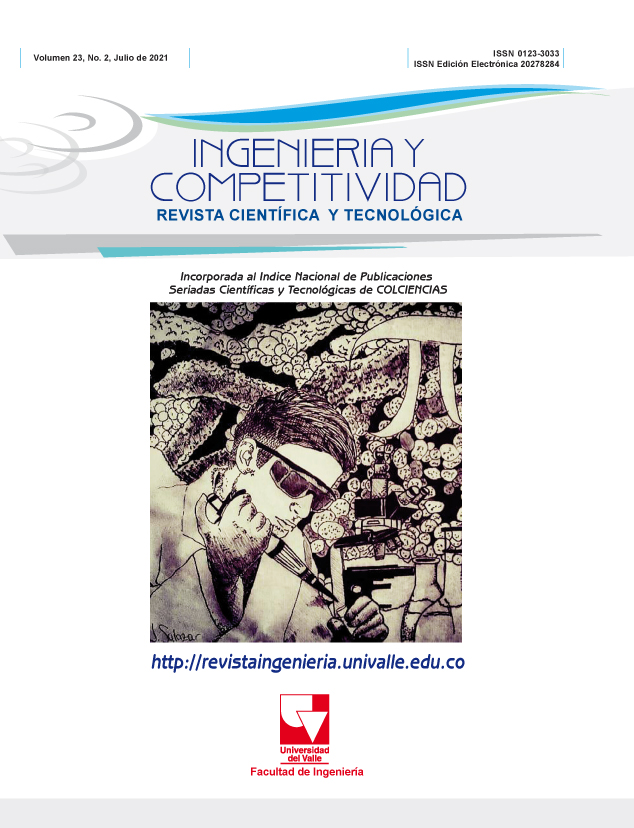Análisis por Elementos Finitos del Proceso de Presión Calibrada Restringida en la Deformación de Láminas de Hierro Armco
Contenido principal del artículo
Se llevó a cabo un análisis exhaustivo del comportamiento elastoplástico de láminas de hierro ARMCO sometidas a deformación plástica severa (SPD) mediante la técnica de presión calibrada restringida (CGP) por medio del método de elementos finitos (FEM). Se consideraron parámetros como la geometría de la matriz y el coeficiente de fricción para estudiar sus efectos en la respuesta elasto-plástica del material. Para ello se utilizó ANSYS workbench para las simulaciones por elementos finitos. Los resultados mostraron que los parámetros estudiados influyen de forma diferente no sólo en la deformación alcanzada sino también en la distribución de la deformación a través de la lámina.
(1) R. Z. Valiev, I. V Alexandrov, Y. T. Zhu, and T. C. Lowe, “Paradox on of strength and ductility in metals processed by SPD,” J. Mater. Res., vol. 17, pp. 5–8, 2002. DOI: https://doi.org/10.1557/JMR.2002.0002
(2) Y. T. Zhu and T. G. Langdon, “The fundamentals of nanostructured materials processed by severe plastic deformation,” Jom, vol. 56, no. 10, pp. 58–63, 2004. DOI: https://doi.org/10.1007/s11837-004-0294-0
(3) I. Sabirov, M. Y. Murashkin, and R. Z. Valiev, “Nanostructured aluminium alloys produced by severe plastic deformation: New horizons in development,” Mater. Sci. Eng. A, vol. 560, pp. 1–24, 2013. DOI: https://doi.org/10.1016/j.msea.2012.09.020
(4) R. B. Figueiredo and T. G. Langdon, “Fabricating ultrafine-grained materials through the application of severe plastic deformation: A review of developments in Brazil,” J. Mater. Res. Technol., vol. 1, no. 1, pp. 55–62, 2012. DOI: https://doi.org/10.1016/S2238-7854(12)70010-8
(5) D. H. Shin, J. J. Park, Y. S. Kim, and K. T. Park, “Constrained groove pressing and its application to grain refinement of aluminum,” Mater. Sci. Eng. A, vol. 328, no. 1-2, pp. 98–103, 2002. DOI: https://doi.org/10.1016/S0921-5093(01)01665-3
(6) A. K. Gupta, T. S. Maddukuri, and S. K. Singh, “Constrained groove pressing for sheet metal processing,” Prog. Mater. Sci., vol. 84, pp. 403–462, 2016. DOI: https://doi.org/10.1016/j.pmatsci.2016.09.008
(7) G. G. Niranjan and U. Chakkingal, “Deep drawability of commercial purity aluminum sheets processed by groove pressing,” J. Mater. Process. Technol., vol. 210, no. 11, pp. 1511–1516, 2010. DOI: https://doi.org/10.1016/j.jmatprotec.2010.04.009
(8) A. Shirdel, A. Khajeh, and M. M. Moshksar, “Experimental and finite element investigation of semi-constrained groove pressing process,” Mater. Des., vol. 31, no. 2, pp. 946–950, 2010. DOI: https://doi.org/10.1016/j.matdes.2009.07.035
(9) S. C. Yoon, A. Krishnaiah, U. Chakkingal, and H. S. Kim, “Severe plastic deformation and strain localization in groove pressing,” Comput. Mater. Sci., vol. 43, no. 4, pp. 641–645, 2008. DOI: https://doi.org/10.1016/j.commatsci.2008.01.007
(10) A. Sajadi, M. Ebrahimi, and F. Djavanroodi, “Experimental and numerical investigation of Al properties fabricated by CGP process,” Mater. Sci. Eng. A, vol. 552, pp. 97–103, 2012. DOI: https://doi.org/10.1016/j.msea.2012.04.121
(11) Z. S. Wang, Y. J. Guan, G. C. Wang, and C. K. Zhong, “Influences of die structure on constrained groove pressing of commercially pure Ni sheets,” J. Mater. Process. Technol., vol. 215, no. 1, pp. 205–218, 2015. DOI: https://doi.org/10.1016/j.jmatprotec.2014.08.018
(12) Z. S. Wang, Y. J. Guan, and C. K. Zhong, “Effects of Friction on Constrained Groove Pressing of Pure Al Sheets,” Adv. Mater. Res., vol. 926-930, pp. 81–84, 2014. DOI: https://doi.org/10.4028/www.scientific.net/AMR.926-930.81
(13) H. R. Rezaei Ashtiani, S. Aradpur, and M. Rafiei, “The Effect of Groove Angles on Groove Pressing Process,” in International Conference on Mechanical Engineering and Advanced Technology, p. October 2012.
(14) M. Borhani and F. Djavanroodi, “Rubber pad-constrained groove pressing process: Experimental and finite element investigation,” Mater. Sci. Eng. A, vol. 546, pp. 1–7, 2012. DOI: https://doi.org/10.1016/j.msea.2012.02.089
(15) K. Peng, X. Mou, J. Zeng, L. L. Shaw, and K.-W. Qian, “Equivalent strain, microstructure and hardness of H62 brass deformed by constrained groove pressing,” Comput. Mater. Sci., vol. 50, no. 4, pp. 1526–1532, 2011. DOI: https://doi.org/10.1016/j.commatsci.2010.12.010
(16) S. Kumar, K. Hariharan, R. Kumar, and S. Kumar, “Accounting Bauschinger effect in the numerical simulation of constrained groove pressing process,” J. Manuf. Process. vol. 38, no. November 2018, pp. 49–62, 2019. DOI: https://doi.org/10.1016/j.jmapro.2018.12.013.

Esta obra está bajo una licencia internacional Creative Commons Atribución-NoComercial-CompartirIgual 4.0.
Los autores que publican en esta revista están de acuerdo con los siguientes términos:
- Los autores conservan los derechos de autor y garantizan a la revista el derecho de ser la primera publicación del trabajo al igual que licenciado bajo una Creative Commons Attribution License que permite a otros compartir el trabajo con un reconocimiento de la autoría del trabajo y la publicación inicial en esta revista. A partir del volumen 22 número 1 (2020), la revista adopta la licencia CC BY-NC-SA 4.0.
- Los autores pueden establecer por separado acuerdos adicionales para la distribución no exclusiva de la versión de la obra publicada en la revista (por ejemplo, situarlo en un repositorio institucional o publicarlo en un libro), con un reconocimiento de su publicación inicial en esta revista.
- Se permite y se anima a los autores a difundir sus trabajos electrónicamente (por ejemplo, en repositorios institucionales o en su propio sitio web) antes y durante el proceso de envío, ya que puede dar lugar a intercambios productivos, así como a una citación más temprana y mayor de los trabajos publicados.





